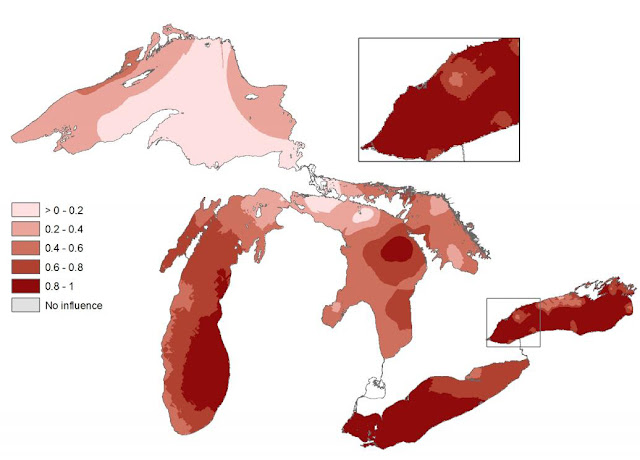Canada and The Great Lakes
Map Displayed Above: The effects of PCBs in the Great Lakes (ppm). Though these toxic compounds haven’t been manufactured and imported since the 1980’s, their consequences have made a lasting effect on the lakes. Adverse side effects associated with PCB exposure include disruption of reproductive function, developmental deficits in children, effects on liver disease and diabetes, and increased cancer risks. (Found via http://www.greatlakesmapping.org/)
We can all agree that the best way to approach the issue of water pollution would be to adhere collective decisions and cooperative actions. This would be considered vital when dealing with large bodies of water, such as the Great Lakes, which cross boundaries with the United States and Canada. According to Environment and Climate Change Canada, "the Great Lakes provide the foundation for billions of dollars in economic activity, and they are a direct source of drinking water for 10 million Canadians” (n.a., 2017). Unfortunately, these large bodies of water are being threatened by land-based pollution, invasive species, and climate change.
Here I would like to introduce the Great Lakes Environmental Assessment and Mapping project (GLEAM). Consisting of twenty American and Canadian researchers and environmentalists, this group evaluates multiple stressors affecting the Great Lakes. They approached the task by mapping the intensity of each stressor. These were divided into seven categories:
• Aquatic habitat alterations: Changes to aquatic habitat from diverse causes, such as shoreline hardening and erosion control structures, port and marina development, and tributary dams
• Climate change: Changes to seasonal, average, and extreme temperature, precipitation, and ice cover
• Coastal development: Land-based human development near lake margins, such as residential and commercial development and industrial activities
• Fisheries management: Changes to Great Lakes ecosystems resulting from fishing pressure, stocking activities, and aquaculture
• Invasive species: Changes to Great Lakes ecosystems from invasive and nuisance species in abundances not previously seen
• Nonpoint source pollution: Nutrients, sediments, and waterborne contaminants transported from watersheds to the Great Lakes by streams and rivers and atmospheric deposition
• Toxic chemical pollution: Chemical pollutants from industrial and agricultural sources
Each link will direct you to information on the individual stressor and will provide you with multiple maps for your viewing. I urge you to share these with others to understand that there are many complex combinations of stresses at play here.
The Great Lakes are important to their neighboring countries because of their water supply for agricultural, domestic, and industrial use. They also provide a home for many wonderful species. What can we do? Spread the word. Raising awareness to the issue of water pollution is helpful in getting individuals motivated and keeping them informed about what they can do to help. GLEAM plans to evaluate interactions among stressors that may increase their influence and improve understanding about how these interactions could repair the issue at hand. GLEAM has partnered with several nonprofit organizations, including the Healing Our Waters Coalition. This organization includes over 100 environmental organizations with different locations and missions, making it easy for you to help. For more information, visit: http://www.healthylakes.org/
Life is full of choices… make the right choice! I believe we can all make choices to help and improve our future and the future of others. Please visit any of the previous websites I have posted to see how you can be a part of this positive change for the future. As a team, we can make a change for the better for our country, for Canada, and for others!
Sources:
Government
of Canada, Environment and Climate Change Canada. (2017, June
20). Environment and Climate Change
Canada - Water - Great Lakes.
Retrieved
July 14, 2017, from https://www.ec.gc.ca/grandslacs-greatlakes/



Comments
Post a Comment
Let your knowledge, ideas, and innovation be heard. Tell us what you think and know about this topic.